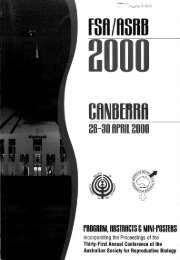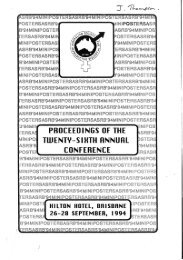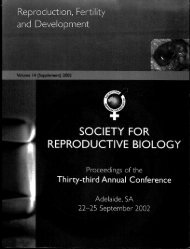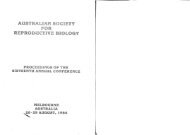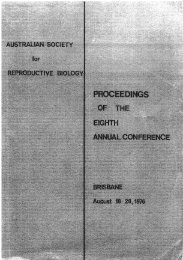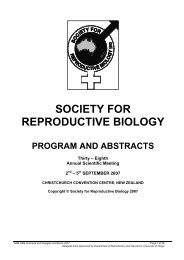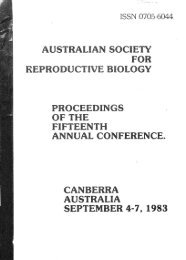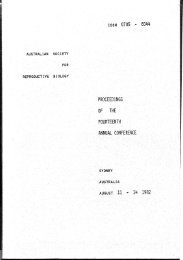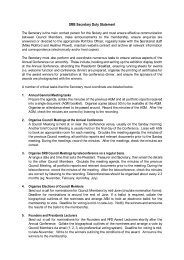N OCIETY' - the Society for Reproductive Biology
N OCIETY' - the Society for Reproductive Biology
N OCIETY' - the Society for Reproductive Biology
You also want an ePaper? Increase the reach of your titles
YUMPU automatically turns print PDFs into web optimized ePapers that Google loves.
. INTERSPECIFIC VARIATION IN GLYCOCONJUGATES OF THE ZONAE PELLUCIDAE OF SEVERALMARSUPIAL SPECIESLA. Chapman, O.W. Wiebkin l and.W.G. BreedDepartment of Anatomical Sciences, University of Adelaide, SA 5005 and IDepartment ofMedicine, University ofAdelaide,.SA 5005'I "-" :Jl' ,"'; C' 1.-...-"!\v J ,.:,> .:..y_.J\Introduction .jThe eggs of all vertebrates are surrounded by a glycoprotein coat known as <strong>the</strong> zona pellucida (ZP). It is to thisstructure that sperm must fIrst bind, and <strong>the</strong>n penetrate, be<strong>for</strong>e fertilisation can occur. Sperm-ZP binding is facilitated by<strong>the</strong> glycoconjugates of <strong>the</strong> ZPs oligosaccharides (1). While <strong>the</strong> protein components of <strong>the</strong> mammalian ZP glycoproteinshave been shown to be highly homologous, <strong>the</strong>re appear to be interspecifIc differences in glycoconjugate content (2).While we have previously shown interspecific variation in thicknesses of marsupial ZPs, ranging from IJllD in <strong>the</strong>opossum to 8-10JllD in <strong>the</strong> koala (3), almost no work has been per<strong>for</strong>med on characterising <strong>the</strong> glycoconjugatecomposition of marsupial ZPs. The aim of this study, <strong>the</strong>re<strong>for</strong>e, was to determine and characterise, by <strong>the</strong> use ofdifferential lectin binding toge<strong>the</strong>r with enzyme elimination and saponification, <strong>the</strong> saccharide components of <strong>the</strong> ZPsof follicular oocytes of several marsupial species each representing a different family within <strong>the</strong> marsupial infrac1ass.Materials and MethodsOvaries of brushtail possums (Trichosurus vuIpecuIa), fat-tailed dunnarts (Sminthopsis crassicaudata), koalas(Phascolarctos cinereus), eastern grey kangaroos (Macropus giganteus) and grey short-tailed opossums (Monodelphisdomestica) were fixed in Rossman's fluid (90% ethanol saturated with picric acid and 10% <strong>for</strong>malin). They were <strong>the</strong>nroutinely processed <strong>for</strong> light microscopy, embedded in paraffIn wax and sectioned. Sections were <strong>the</strong>n deparaffinised,rehydrated, blocked with 1% BSA in Tris-buffered saline and incubated with one of 7 FITC-conjugated lectins andviewed under a fluorescent microscope. To detect sugar residues masked by sialic acid or O-acetyl groups, sectionswere first ei<strong>the</strong>r desialylated (4) or saponified (5) respectively, prior to incubation with <strong>the</strong> lectins, as previouslydescribed. Specific controls involved incubating <strong>the</strong> lectins with 0.2-0AM of <strong>the</strong>ir inhibitory sugar prior to applicationto <strong>the</strong> ovary sections. Results were recorded as positive (+) or negative (-) binding, with positive binding beingsubjectively categorised into mild (+), strong (++) and intense (+++).Results and DiscussionThere is considerable variation in glycoconjugate content of marsupial ZPs. The ZPs of <strong>the</strong> fat-tailed dunnartsdisplayed <strong>the</strong> most deviation in <strong>the</strong>ir saccharides from those of o<strong>the</strong>r marsupial ZPs, with positive reactivity to alliectinsoccurring after desialyation (Table 1) and saponification (Table 2). Most signifIcantly, a-D-mannose, as demonstratedby Con A, was found only in <strong>the</strong> saponified ZPs of <strong>the</strong> fat-tailed dunnarts and no o<strong>the</strong>r species. The presence ofmannose may indicate, <strong>for</strong> <strong>the</strong> fIrst time, <strong>the</strong> presence ofN-linked oligosaccharides in <strong>the</strong> ZPs of dunnarts.ZPs of all species, except those of <strong>the</strong> opossum, appeared sialylated with increases in binding <strong>for</strong> f3-Gal(I-3)GaINAc(PNA) and a-D-Gal(NAc) (SBA) after removal of sialic acid with neuraminidase. O<strong>the</strong>r glycoconjugates like <strong>the</strong>disaccharides f3-Gal(1-4)GlcNAc and f3(1-4)-D-GlcNAc, as demonstrated by <strong>the</strong> lectins ECA and WGA respectively,appear to be common components within <strong>the</strong> ZPs of marsupials. The <strong>for</strong>mer, however, also appears to be masked tosome extent by O-acetyl groups, with increases in binding to ECA after saponification.Table 1. Lectin binding to ZPs of 5 marsupial speciesbe<strong>for</strong>e and, in brackets, after desialyationBrushtall Fat-tailedPossum Dunnart Koala Kane:aroo OoossumPNA ++(+++) - (++) ++(+++) ++(+++) +(+)RCA·I1 -(-) +(++) +(+) - (+) -(-)WGA +++(+++) ++(+++) +++(+++) +++(+++) ++(++)SNA 0(+) +(++) ++(++) 0(+) -(-)SBA - (+) 0(+) - (++) -C++) -(-)Table 2. Lectin binding to ZPs of 5 marsupial speciesbe<strong>for</strong>e and, in brackets, after saponificationBrushtail Fat-tailedPossum Dunnart Koala Kanl!aroo OoossumPNA ++(+++) - (+) ++(++) ++(+++) +(++)ECA - (+++) - (+) +(++) +(++) +(++)Con A 0(_) - (+++) -(-) - (0) -(-)RCA-II 0(_) +(+) +(+) - (+) -(-). WGA +++(+++) ++(++) +++(+++) +++(+++) ++(+++)SNA - (0) +(+) ++(++) - (++) - (++)SBA -(-) - (++) -(-) 0(0) -(-)ConclusionWhile marsupial ZPs contain common saccharide components such as GlcNAc and GalNAc, which are also commonin eu<strong>the</strong>rian mammalian ZPs (2), <strong>the</strong>y also display considerable interspecific variation in <strong>the</strong>ir glycoconjugate content.Whe<strong>the</strong>r this variation relates to <strong>the</strong> species-specificity of sperm-ZP binding is unknown. Fur<strong>the</strong>r work is required toelucidate this.References1. Florman, H.M., and Wassarman, P.M. (1985) Ce1141:313-324.2. Skutelsky, E., et al., (1994) J Reprod Fertill00:35-41.3. Chapman, lA., and Breed, W.G. (1998) Aust Mamm Soc conference proceedings, Perth Australia:23.4. Riley, C.B., and Elhay, MJ. (1994) Ch. 3. In I Laboratory Histopathology: A Complete Reference'68IMMUNOCONTRACEPTION FOR WILDLIFE CONTROL:THE ZONA PELLUCIDA AS A TARGET IN MACROPODS.A.L. Kitchener, DJ. Kay and L.M. EddsMarsupial CRC, Unive:sity of Newcastle, Callaghan NSW 2308, Australia.IntroductionBy altering <strong>the</strong> landscape <strong>for</strong> agriculture andgrazing we have allowed .<strong>the</strong> numbers of. somespecies of macropods to Increase dramatIcally.This has lead to environmental degradation andcompetition <strong>for</strong> resources. Contraceptivevaccines are being investigated as a means ofcontrolling problem population of macropods(1). The zona pellucida (ZP) is beingconsidered as a target as it per<strong>for</strong>ms essentialfunctions in fertilisation' (2). This study hasbeen conducted to provide proof of concept <strong>for</strong>ZP molecules as potential target antigens in acontraceptive vaccine <strong>for</strong> macropods.Materials & Methods16 female Tammar wallabies (Macropuseugenii) were divided evenly into two treatmentgroups. The first group was immunised on 5occasions, at <strong>for</strong>tnightly intervals, with l00J.lgof whole porcine zona pellucida (PZP)emulsified in Freunds complete adjuvant <strong>for</strong> <strong>the</strong>initial injection and incomplete Freunds <strong>for</strong> <strong>the</strong>second and subsequent injections. Thevaccinations were distributed over 4 sites, twosubcutaneous and two intramuscular. Thecontrol group received saline and Freundsadjuvant in <strong>the</strong> same manner. Blood sampleswere collected each time <strong>the</strong> animals wereimmunised and <strong>the</strong>reafter at monthly intervals.After <strong>the</strong> fifth injection <strong>the</strong> animals were placedin a breeding trial with two PZP and two controlanimals placed with two stud males in eachbreeding group. Success of natural mating andartificial insemination after super-ovulation (3)were used to assess <strong>the</strong> fertility of animals ineach group. Animals were sacrificed at <strong>the</strong> endof <strong>the</strong> breeding trial and <strong>the</strong> reproductive tractscollected <strong>for</strong> immunohistology. Immuneresponses were evaluated using ELISAs andwestern blots (4).ResultsImmunised wallabies produced strong andsustained immune responses to PZP (Figure 1).67% of control animals produced offspring bynormal mating. PZP immunised animals failedto produce any offspring. Fertilised ova wererecovered from all control animals that had beenartificially inseminated, showing that 100% ofcontrol animals were fertile. Artificial ~.nsemination demonstrated that PZP immunised\~allabies failed to ovulate. The ovaries of PZP .. )_immunised super-ovulated wallabies were...'1\smaller, 0.239g +/- 0.15,3g co~pared to 0.781g.! +/_ 0.275g, and had fewer folhcles



